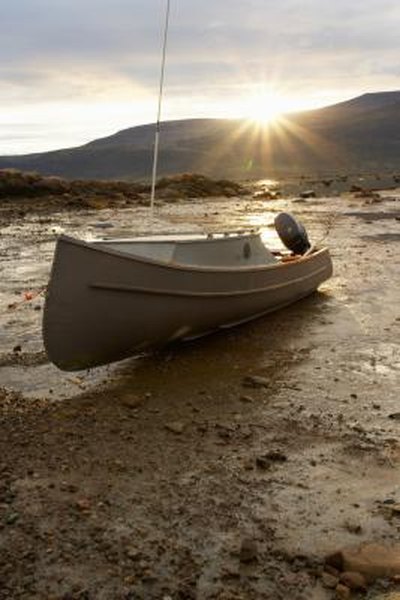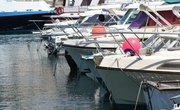
Gasoline-powered outboard motors without built-in fuel tanks must be connected to a remote fuel source. Many outboard manufacturers sell fuel tanks and fuel hose kits with the appropriate fittings built into the hose that will connect to their motors. Tanks with nonstandard fittings require a custom-built hose to complete the connection. Parts for building a fuel hose are available from outboard dealerships, marine hardware stores and even some of the better general hardware stores. You can assemble a fuel hose to connect your fuel tank to your outboard motor using basic tools.
Items you will need
Fuel hose with primer bulb
Inline fuel filter and water separator
Hose clamps
Phillips screwdriver
Fuel tank quick-connector (if applicable)
Brand-specific motor quick-connector
Step 1
Lay the fuel hose out from the desired tank location to the motor. Route the hose so that it is protected from damage and does not present a trip hazard. Ensure that the arrow on the primer bulb points in the direction of the fuel flow -- from the tank to the motor. Cut the fuel hose to length.
Step 2
Cut the hose between the primer bulb and the fuel tank. Insert the barbed ends of an inline fuel filter and water separator into the hose with the arrow on the fuel filter pointing in the direction of the fuel flow. Ensure that the filter is in a protected but accessible area of the boat. Secure the hose to the inline filter using at least two hose clamps and a Phillips screwdriver.
Step 3
Insert the fuel tank quick-connector into the fuel-tank end of the hose and secure it, using a hose clamp and Phillips screwdriver. Fuel tanks without a quick-connector built in will have a barbed fitting instead. Slide the fuel hose onto the barbed fitting and secure it using a hose clamp and Phillips screwdriver.
Step 4
Insert the brand-specific quick connector into the motor end of the fuel hose. Secure the connector using a hose clamp and Phillips screwdriver.
Step 5
Squeeze the release tab on the motor quick connector and slide it onto the motor fuel fitting. Release the tab and push the connector toward the motor until the release tab and connector snap into position.
Step 6
Fill the fuel tank. Open the fuel tank vent, if the tank is not self-venting. Pump the primer bulb in the fuel hose until the inline filter is filled with fuel and the bulb has a firm feel when it is squeezed. Check all of the fuel line connections for leaks.
Warnings
- Make certain the fuel line is rated for gasoline use, not diesel, and that it is formulated for use with fuel containing ethanol. Ethanol is a relatively new additive to fuel. Ethanol can damage and degrade older types of fuel hoses and can lead to loss of engine power during operation.
- Buy and carry spare filters for your inline fuel filter and water separator as well as the necessary tools to replace the filter when under way. Contaminated fuel from a dirty tank or filling station can clog the filter and leave you stranded if you cannot replace the filter.
- Ensure that your fire extinguisher is rated for gasoline fires and that it is fully charged and readily accessible.
- Never operate a boat that is leaking gasoline. Gas fumes are heavier than air and will collect in the bilges and other low spots in the boat. Sparks from non-ignition protected components and open flames, such as from cigarette lighters, can cause the fumes to explode.
References
- Capt. TJ Hinton; commercial fisherman; Gulfport, Mississippi
Warnings
- Make certain the fuel line is rated for gasoline use, not diesel, and that it is formulated for use with fuel containing ethanol. Ethanol is a relatively new additive to fuel. Ethanol can damage and degrade older types of fuel hoses and can lead to loss of engine power during operation.
- Buy and carry spare filters for your inline fuel filter and water separator as well as the necessary tools to replace the filter when under way. Contaminated fuel from a dirty tank or filling station can clog the filter and leave you stranded if you cannot replace the filter.
- Ensure that your fire extinguisher is rated for gasoline fires and that it is fully charged and readily accessible.
- Never operate a boat that is leaking gasoline. Gas fumes are heavier than air and will collect in the bilges and other low spots in the boat. Sparks from non-ignition protected components and open flames, such as from cigarette lighters, can cause the fumes to explode.



